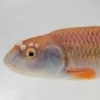 100_0144.jpg 332.82KB
5 downloads
100_0144.jpg 332.82KB
5 downloadsOn the not-pictured underside, there is a large suction disk, on what I assume is the tail end. I put him on my hand this morning, but he did not try to attach to me, rather just moved back into the water.

Posted 22 May 2007 - 07:03 AM
 100_0144.jpg 332.82KB
5 downloads
100_0144.jpg 332.82KB
5 downloadsPosted 22 May 2007 - 07:55 AM
Posted 22 May 2007 - 10:27 AM
Looks like a Placobdella sp. also called a Turtle leech. It's a bit hard to ID these things without looking and mouth parts and suckers and stuff..But this would be the best fit on looks alone
If it is a turtle leech it is a parasite not recommended to keep in a fish tank. Some species are parasitic on fish but most are Reptile and amphibian feeders.
Posted 09 April 2016 - 12:37 PM
Michael,---I followed the link you attached from another post here. Did you ever add that guy to your snail tank? If so, how did it do on the war against snail?
On the topic of leeches, a lot come in with live blackworm cultures. However they appear to be detritivores as I've never seen the MTSnail population decrease even with lots of the detrito-leeches living in the gravel.
Posted 09 April 2016 - 12:50 PM
This does look just like the ones I find on snapping turtles.
The member formerly known as Skipjack
Posted 09 April 2016 - 12:51 PM
I didn't read this all I just remembered I had posted a picture... but to tell the story correctly...
I put him in a 6 gallon tank in my office at work (at the time) that housed one very mean, very old F. cingulatus. They both survived quite fine on general office neglect and the live plants and live snails that were all over that little tank. Yes we did see a mild introduction of the larger snails, but not really significant. He was way cool and I would drop the next one I see in my "collecting to take home" bucket.
After about a year I left that job and actually left the aquarium with some folks there, so I don't have a longer term update.
Posted 09 April 2016 - 01:36 PM
10-4. Thanks for the update. Hadn't thought about keeping any of the turtle leeches as pets before. And the incidentals that come in with blackworms aren't as big or neat as the one pictured above. It is amusing to see them come out of the gravel like zombies when algae wafers are dropped in.
Posted 09 April 2016 - 01:47 PM
The small gray leeches that come with blackworms eat blackworms. If you don't believe me try starving one for a few days and then drop in a blackworm. I assume they'll scavenge dead animals too.
Gerald Pottern
-----------------------
Hangin' on the Neuse
"Taxonomy is the diaper used to organize the mess of evolution into discrete packages" - M.Sandel
Posted 09 April 2016 - 02:01 PM
Never knew that. Thanks for the tip. However, large, hungry Cyprinella sp. make short work of said leeches!
Posted 11 April 2016 - 08:25 PM
You don't want that big guy in your tank with fish. I've found them on turtles, and I imagine they'd probably grab most fish.
Posted 11 April 2016 - 09:22 PM
You don't want that big guy in your tank with fish. I've found them on turtles, and I imagine they'd probably grab most fish.
Did you read the thread? He was fine. Attached to the acrylic tank sometimes, attached on and killed some snails. He was cool.
0 members, 1 guests, 0 anonymous users